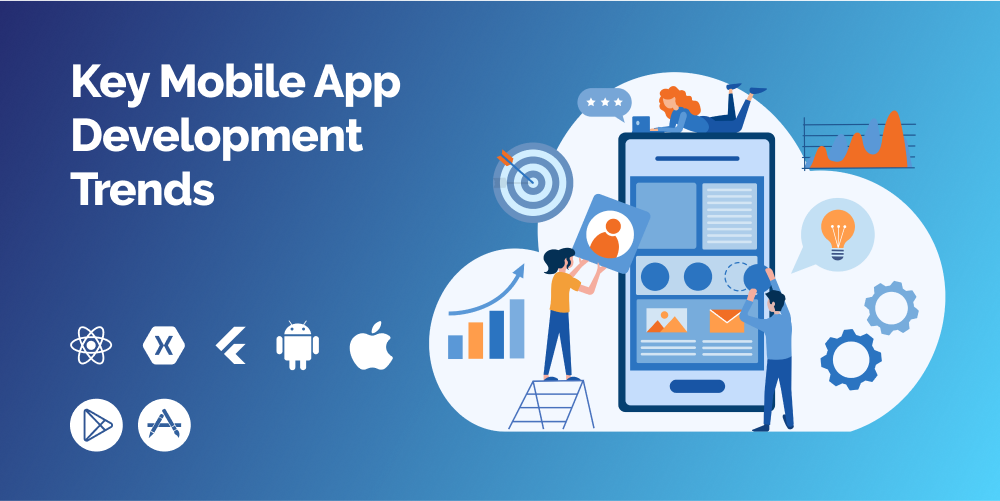Mobile App Development, zBlog
Key Mobile App Development Trends to Watch in 2023
atif | Updated: September 1, 2023

The mobile app industry continues to increase, with the global market expected to reach $935 billion in 2023. Developers need to stay updated on the latest mobile app development trends as consumer expectations evolve and new technologies emerge. In 2023, several key trends will shape the future of mobile apps and enable developers to create more engaging and integrated experiences.
The Dominance of Mobile
Mobile usage has exploded over the past decade. Today, the average person spends 4.8 hours per day on their mobile device. Much of this time is spent in apps, with 70% of all US digital media time occurring via mobile apps. It’s clear that mobile is dominant, and this trend will only grow stronger. Businesses must have a robust mobile strategy, with a feature-rich app at the core, to engage today’s mobile-centric users.
Proliferation of Apps

The app stores already offer staggering app numbers, with over 2.9 million Android apps and 4.75 million iOS apps available. These numbers will continue rising as businesses realize the value of reaching consumers through apps. Standing out will require unique value propositions, excellent UI/UX design, and leveraging new features like augmented reality.
Maturing App Categories
While games, social media, and productivity apps continue to rank among the most popular app categories, maturation occurs within categories like retail, automotive, and financial apps. Users now expect specialized, advanced functionality from apps in these verticals. Developers must tap into these expectations with apps offering seamless real-world integration.
Quickly Evolving Feature Expectations
User expectations for apps are evolving at lightning speed thanks to the pace of technological change. For example, 63% of users expect an app to load in 4 seconds or less, or they will abandon it. Staying ahead of expectations requires diligent testing and monitoring of metrics like load times, crash rates, and customer feedback.
AI & Machine Learning Integration
Artificial intelligence and machine learning disrupt mobile apps, enabling more predictive and personalized experiences. Chatbots, digital assistants, auto-complete, and recommendation engines are just a few examples of these mobile app development trends. In 2023, expect AI and ML to become table stakes for sophistication among mobile apps.
Advanced App Security

With expanding amounts of sensitive personal data housed in apps, security must be considered. More apps will implement biometric authentication, enforce API security standards like OAuth 2.0, and encrypt stored data. Security audits will also become regular practice for apps holding sensitive info.
Cross-Platform Development

Supporting both major mobile platforms is crucial, with 58% of users only engaging apps available on their preferred platform. Cross-platform frameworks like React Native and Flutter are gaining adoption by allowing nearly simultaneous iOS and Android development. Their minimal performance tradeoffs vs. native development make these frameworks wise choices for many apps.

PWAs Become Mainstream
Progressive web apps (PWAs) are closing the gap between websites and mobile apps. Offering app-like functionality combined with web reach, PWA’s adoption will accelerate in 2023. For apps without advanced native requirements, PWAs will offer cost savings and streamlined maintenance using standardized web languages.
5G Speeds Unlock Innovation

As 5G networks continue rolling out, apps will capitalize on the ultra-fast speeds and low latency. AR/VR apps, real-time multiplayer gaming, video streaming, and IoT apps will thrive thanks to 5G. This new backbone will remove limitations, opening the door for innovative apps.
Voice & Chat Advancements

Natural language processing keeps improving, enabling more advanced voice control and chatbot capabilities. In 2023, expect closer integration of voice assistants like Siri and Alexa with apps for hands-free use. For customer service, chatbots will become more intelligent and conversational.
Rising Importance of UX
Stiff competition means apps live and die based on their user experience. Going into 2023, UX will make or break app adoption and retention. Successful apps will thoughtfully choreograph each screen and interaction to minimize friction and guide users to their end goal. As mobile app development trends continue to evolve, UX design will be a key factor in determining an app’s success.
AR & VR Gain Traction

While still maturing, augmented and virtual reality finally have the technological foundation for more mainstream adoption. Retail and gaming apps, in particular, will integrate AR/VR to engage customers more effectively. The stage is set for AR and VR to transition from novelty to utility.
Expanding IoT App Integration
IoT proliferation expands the possibilities for connected mobile apps. In 2023, we’ll see apps integrating with smart devices for home automation, health and fitness monitoring, and context-aware functionality. More apps will assume persistent connectivity and interaction with other devices.
Continuous Delivery Prioritization
Mobile teams must continually iterate and deliver app updates to keep pace with user expectations. Agile processes, cloud infrastructure, and DevOps culture allow teams to release changes nearly continuously. The most successful apps will have mastered continuous delivery pipelines to accelerate enhancements.
Subscription & Freemium Models

Paid app downloads will give way to subscriptions and freemium models. Subscriptions build ongoing revenue while allowing “try before you buy.” Freemium converts users initially via free access before unlocking advanced features for a paid subscription. Both models hinge upon continuously enhancing the app to demonstrate ongoing value.
Enterprise Mobile App Ascent
Mobile apps are no longer optional for engaging enterprise employees and customers. Off-the-shelf solutions enable companies to quickly deploy apps for field workers, sales teams, HR needs, and more. In 2023, enterprise app adoption will surge as mobility and digitization converge for business aims.
Wearables & Microapps
As wearables like smartwatches and fitness trackers go mainstream, micro apps customized to these devices will rise in prominence. Rather than recreating full apps, developers can offer streamlined micro-apps with essential features reimagined for wearables’ constraints. Less can be more for enhancing wearables.
App Marketing & Monetization Diversify
Innovation in-app marketing and monetization strategies will intensify as competition mounts. Subscriptions, in-app purchases, contextual advertising, and organic promotion via influencers and social media will co-exist for diverse revenue and discovery. Effective measurement and testing will determine optimal blends.
Everything Becomes an App
Apps will continue permeating new parts of life as users seek more convenient and immediate access to services. App functionality may be embedded in unexpected devices and interfaces, like mirrors, appliances, and vehicles. The app experience will transform from pocketable to omnipresent.
Focus on Sustainability
Society’s push toward sustainability extends to mobile development. App teams will design for optimal power and bandwidth efficiency, reducing battery and data consumption. Apps may encourage eco-friendly behaviors or promote environmentally sound products and services. Greener app operations will also become best practice.
Regulation & Responsibility
As mobile apps increase in sophistication, so too will regulation. The need for thoughtful policies around data privacy, ethical AI, censorship, and consumer protection will rise. Responsible app teams should get ahead of changes by self-regulating through thorough testing, auditing, and risk analysis.
Conclusion
The mobile app landscape in 2023 promises exciting innovation and progress across technologies like 5G, AI, AR/VR, voice assistants, and more. But with these opportunities come new security, quality, regulations, and sustainability challenges. By keeping users at the center and developing purposefully, mobile teams can architect the app experiences that will dominate the future. App developers who skillfully ride the mobile app development trends in 2023 will shape how billions interact with information, entertainment, shopping, work, and one another through their mobile devices.
Trantor’s full-spectrum mobile app development provides customized solutions across iOS, Android, hybrid, and cross-platform apps. With expertise in UI/UX design, the latest platforms and SDKs, scalable architecture, and end-to-end quality assurance, Trantor empowers businesses through holistic and tailored mobile experiences spanning AR, VR, IoT, wearables, gaming, and beyond. Our verified approach delivers stable, feature-rich, and cost-effective mobile apps optimized for seamless user experiences on any device.




